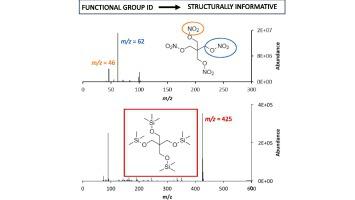Forensic Chemistry ( IF 2.7 ) Pub Date : 2023-12-06 , DOI: 10.1016/j.forc.2023.100543 Ryan M. Bain , Kelli A. Simon , Michelle Clarke , Douglas J. Klapec

|
Forensic investigations of explosives in post-blast and trace scenarios often utilize gas chromatography-mass spectrometry (GC–MS). Many high explosives (e.g., trinitrotoluene) provide structurally significant ions so that a compound can be confidently identified by GC–MS; however, GC–MS only provides functional group identification for the presence of nitrate esters (e.g., nitroglycerin (NG)), a class of high explosives that is frequently encountered in forensic casework. Nitrate esters vary drastically and are much more accurately identified by their component alcohol structure rather than merely the detection of the nitrate and nitrite ions. Herein, we demonstrate a two-step derivatization reaction requiring no purification steps or advanced sample preparation and characterize several of the reaction byproducts created along with the desired reaction product. In this process, nitrate esters are initially reduced to their component alcohol, and then subsequently silylated. The resulting product, when submitted to GC–MS with positive ion mode chemical ionization, provides mass spectra that characterizes the component alcohol by the pseudo-molecular ion of the reaction product. GC–MS with negative ion mode chemical ionization confirms the presence of a nitrate functional group by the characterization of the unreacted starting material. These results combine to identify nitrate esters in forensic settings, and as a proof of concept, we demonstrate the applicability of the derivatization reaction to pentaerythritol tetranitrate (PETN), NG, and erythritol tetranitrate (ETN) standards, as well as a formulated composition containing PETN-SEMTEX 1A, homemade ETN, and post-burn samples.
中文翻译:

通过气相色谱-质谱法产生具有结构信息的离子的硝酸酯衍生化
爆炸后和痕量场景中爆炸物的法医调查通常利用气相色谱-质谱法 (GC-MS)。许多烈性炸药(例如三硝基甲苯)提供结构上重要的离子,因此可以通过 GC-MS 自信地鉴定化合物;然而,GC-MS 只能对硝酸酯(例如硝酸甘油 (NG))的存在提供官能团鉴定,硝酸酯是法医案件工作中经常遇到的一类烈性爆炸物。硝酸酯的变化很大,通过其成分醇结构来识别要准确得多,而不仅仅是检测硝酸根和亚硝酸根离子。在此,我们演示了不需要纯化步骤或高级样品制备的两步衍生反应,并表征了与所需反应产物一起产生的几种反应副产物。在此过程中,硝酸酯首先被还原为其组分醇,然后进行甲硅烷基化。将所得产物提交给采用正离子模式化学电离的 GC-MS 时,可提供质谱,通过反应产物的准分子离子来表征组分醇。采用负离子模式化学电离的 GC-MS 通过未反应起始材料的表征证实了硝酸盐官能团的存在。这些结果结合起来鉴定法医环境中的硝酸酯,作为概念证明,我们证明了衍生反应对季戊四醇四硝酸酯 (PETN)、NG 和赤藓糖醇四硝酸酯 (ETN) 标准品以及含有PETN-SEMTEX 1A、自制 ETN 和燃烧后样品。



























 京公网安备 11010802027423号
京公网安备 11010802027423号